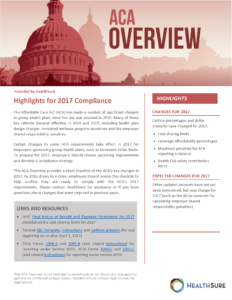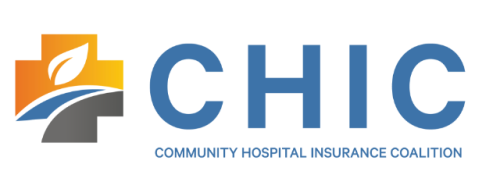Contents
Judge Blocks Overtime Rule Set to Take Effect December 1
Congress Passes Law Expanding use of HRAs by Small Employers
2017 Marketplace Plan Premiums Rise 25 Percent
Did you know? IRS released Revenue Procedure 2016-55
Judge Blocks Overtime Rule Set to Take Effect December 1
by Stacy Barrow and Steve Weatherhead
On Tuesday, November 22 a federal judge issued a nationwide injunction blocking the U.S. Department of Labor (“DOL”) from implementing its new overtime rule scheduled to take effect December 1, 2016. The rule would have affected approximately 4 million executive, administrative and professional (“EAP”) employees, making them eligible for time-and-a-half pay for all hours worked in excess of 40 per week if their salary is below $913 per week ($47,476 per year). The new threshold would have doubled the current threshold of $455 per week ($23,660 per year).
The case, State of Nevada v. DOL, was presided over by Judge Amos Mazzant, an Obama appointee to the United States District Court for the Eastern District of Texas. The lawsuit was filed by the Attorneys General for Texas and Nevada and was joined by 19 other states. The states alleged that the DOL’s overtime rule is illegal because the minimum salary threshold of $47,476 makes millions of EAP employees non-exempt when their duties clearly qualify them to be treated as exempt.
The Court agreed, finding that the minimum salary level and the automatic updating mechanism in the new regulations are without statutory authority under the Fair Labor Standards Act (“FLSA”). Essentially, the Court concluded that the new rule imposed a de facto minimum wage requirement for EAP employees of $47,476, which exceeds the DOL’s authority under the FLSA and is contrary to Congressional intent. Under the FLSA, bona fide EAP employees are exempt from minimum wage and overtime requirements.
The decision is a blow to the president’s overtime regulation, which was intended to boost workers’ paychecks in the face of stagnant wages. Even if the Court ultimately restores the new overtime rule, it is likely to be revised by President-Elect Trump through additional rule-making or legislation.
Congress Passes Law Expanding use of HRAs by Small Employers
by Marathas Barrow
Congress Passes Law Expanding use of HRAs by Small Employers
On December 7, 2016, the Senate passed the 21st Century Cures Act (“Cures Act”), an omnibus measure that includes the Small Business Healthcare Relief Act (“Relief Act”), which significantly expands small employers’ options for providing health coverage. The Cures Act passed  both houses of Congress by a wide margin and the President has indicated that he will sign it into law. Once signed, the law will be effective for plan years beginning on or after January 1, 2017. The Relief Act is Title XVIII of the Cures Act and starts on page 824.
both houses of Congress by a wide margin and the President has indicated that he will sign it into law. Once signed, the law will be effective for plan years beginning on or after January 1, 2017. The Relief Act is Title XVIII of the Cures Act and starts on page 824.
The HRA Relief Act allows small employers—defined as those who are not applicable large employers (“ALEs”)—to establish a qualified health reimbursement arrangement (“HRA”) that reimburses eligible employees and their family members for medical expenses, including individual health insurance premiums, up to a specified annual limit. In general, an employer is an ALE if it employed at least 50 full-time equivalent employees on average in the prior calendar year.
Eligible Employers
An eligible employer cannot be an ALE and cannot offer a group health plan to any of its employees. A qualified HRA must be funded solely by employer contributions (i.e., no salary reduction contributions) and must be available to all “eligible employees.”
Eligible Employees
“Eligible employees” include all employees of the employer, except for employees in the following categories, who may be excluded:
- those who have not completed 90 days of service;
- those under the age of 25;
- part-time and seasonal employees;
- those covered by a collective bargaining agreement, if accident and health benefits were the subject of good faith negotiations; and
- nonresident aliens with no U.S.-source income from the employer.
To participate, eligible employees must demonstrate that they and any participating family members have enrolled in minimum essential coverage (“MEC”).
Annual Limit
Amounts available under a qualified HRA cannot exceed $4,950 per year, as indexed ($10,000 if the HRA also covers family members). The annual limits are prorated for partial years of coverage. The employer’s annual contribution must be the same for all eligible employees; however, certain variations are permitted with respect to HRA funds that are available for reimbursement of individual market coverage. Employer contributions to a qualified HRA may vary in accordance with the price of an individual market health insurance policy based on the age of the eligible employee (and the age of covered family members) or the number of an eligible employee’s covered family members. For example, an employer contribution equivalent to 80% of the cost of age-banded coverage up to $4,950 per year would be permissible.
Notice Requirements
Employers must notify eligible employees of the availability of a qualified HRA at least 90 days prior to the beginning of the plan year or upon eligibility for employees who become eligible during the year. The notice must state: (1) the amount available under the HRA for the year; (2) that employees receiving federally subsidized coverage must disclose the HRA contribution to the Marketplace; and (3) that if the employee does not have MEC, an individual mandate penalty may apply and any reimbursement from the HRA may be included in gross income that month.
Failure to provide the notice as required may result in a penalty of $50 per employee, not to exceed $2,500 per year. Employers offering qualified HRAs early in 2017 will not be exposed to penalties for failure to provide a notice to employees upon becoming eligible so long as notice is provided by April 1, 2017.
Federal Premium Subsidy Reduction
Employees participating in a qualified HRA will have their monthly federal premium subsidy for Marketplace coverage reduced by 1/12th of the employer’s annual HRA contribution. For example, if an employee’s subsidy is $250 per month and 1/12th of the employer’s annual HRA contribution is $200, the employee’s subsidy will be reduced to $50 per month.
In addition, if the HRA provides “affordable” coverage, the employee’s subsidy will be reduced to zero that month. An HRA provides affordable coverage in any month where the difference between the cost of coverage under the second-lowest-cost silver plan in the Marketplace and the employer’s HRA contribution does not exceed 9.5% (9.69%, as indexed for 2017) of the employee’s household income.
Example: In 2017, if the second-lowest cost silver plan in the employee’s Marketplace is $300 per month, 1/12th of the employer’s annual HRA contribution is $100 and the employee earns $2,100 per month, the employee will not be eligible for a federal premium subsidy because $2,100 × 9.69% = $203, which exceeds the $200 difference between the applicable Marketplace plan and the employer’s monthly HRA contribution.
Reporting Requirements
The Relief Act requires employers to report amounts available under a qualified HRA on employees’ Form W-2. Presumably, it will be reported for informational purposes in box 14. Employees will also be required to report the amount available under a qualified HRA, likely as part of their subsidy application.
Effect on Other Laws
Under the Relief Act, qualified HRAs will not be considered group health plans under ERISA and, with the exception of the Cadillac tax, will not be subject to the ACA’s market reforms, including ACA reporting for self-insured plans. Thus, qualified HRAs will not be subject to COBRA continuation requirements. Also, given the incoming Administration, it’s not clear whether the Cadillac tax will survive long enough see its intended effective date of 2020.
Thoughts from MBWL
The Relief Act will be well-received by many small employers, although the extent to which the qualified HRA approach will provide a major advantage over traditional group health insurance (which allow pre-tax contributions) is unclear. Employers should work with their trusted benefit advisors when considering their approach. It is also likely that the Internal Revenue Service will release additional guidance in the following months.
2017 Marketplace Plan Premiums Rise 25 Percent
The open enrollment period for obtaining health coverage for 2017 through the Affordable Care Act (ACA) Marketplace begins Nov. 1, 2016, and ends Jan. 31, 2017. The 2017 Marketplace looks a bit different than it did last year, especially in regards to increased premium costs.
According to a report from the Department of Health and Human Services (HHS), premiums for a midlevel benchmark plan from the federal Marketplace will increase an average of 25 percent. This is a significant increase when compared to the 7 percent increase in 2016 and the 2 percent increase in 2015.
Despite this increase, the Obama administration states that about 70 percent of Marketplace consumers will be able to obtain a health plan for less than $100 per month with the use of subsidies and smart shopping.
Experts believe that inaccurate predictions, the exit of insurance companies from the Marketplace and the overall rise in health care costs contributed to this nationwide increase in premium costs.
Inaccurate Predictions
McKinsey & Company, a top global consulting firm, found that as of 2015, insurance companies lost $2.7 billion on the individual market. A large factor contributing to this loss of revenue was that insurers had to pay for more claims than they expected. Though the government offers several programs to aid in redistributing insurance risk, not all companies have benefited, which has resulted in continued losses.
Exit of Insurance Companies from the Marketplace
Many of the insurers who experienced large losses in revenue or offered money-losing plans will not return to the Marketplace in 2017. Three major insurers (Aetna, Humana and UnitedHealthcare) pulled out of the Marketplace in many states and will not offer health plans for 2017. Fewer plans on the Marketplace means that there is less competition between companies that could help drive down plan prices.
Rise in Health Care Costs
Top factors contributing to the rise in health care costs include inflation, an aging population, and the growing cost of prescription and specialty drugs and treatments. All of these factors combined with increased utilization can drive up premiums for the entire pool of insured consumers.
ACA Overview 2017

The Affordable Care Act (ACA) has made a number of significant changes to group health plans since the law was enacted in 2010. Many of these key reforms became effective in 2014 and 2015, including health plan design changes, increased wellness program incentives and the employer shared responsibility penalties.
Certain changes to some ACA requirements take effect in 2017 for employers sponsoring group health plans, such as increased dollar limits. To prepare for 2017, employers should review upcoming requirements and develop a compliance strategy.
This ACA Overview provides a short checklist of the ACA’s key changes in 2017. As 2016 draws to a close, employers should review this checklist to help confirm they are ready to comply with the ACA’s 2017 requirements. Please contact HealthSure for assistance or if you have questions about changes that were required in previous years.
 In late October, the IRS released Revenue Procedure 2016-55 (Rev. Proc. 16-55). Rev. Proc. 16-55 increased the flexible spending account (FSA) dollar limit on voluntary employee salary reduction contributions to $2,600 for taxable years beginning in 2017.
In late October, the IRS released Revenue Procedure 2016-55 (Rev. Proc. 16-55). Rev. Proc. 16-55 increased the flexible spending account (FSA) dollar limit on voluntary employee salary reduction contributions to $2,600 for taxable years beginning in 2017.
Employers should ensure that their health FSAs will not allow employees to make pre-tax contributions greater than $2,600 for 2017. Employers may continue to impose their own health FSA limits, as long as they do not exceed the ACA’s maximum limit for the plan year. For example, an employer may continue to use the 2016 maximum limit for its 2017 plan year.
Regardless of the FSA limit an employer chooses, it should be certain to communicate it to employees as part of the open enrollment process.
The information provided in this alert is not, is not intended to be, and shall not be construed to be, either the provision of legal advice or an offer to provide legal services, nor does it necessarily reflect the opinions of the agency, our lawyers or our clients. This is not legal advice. No client-lawyer relationship between you and our lawyers is or may be created by your use of this information. Rather, the content is intended as a general overview of the subject matter covered. HealthSure and Marathas Barrow Weatherhead Lent LLP are not obligated to provide updates on the information presented herein. Those reading this alert are encouraged to seek direct counsel on legal questions.


